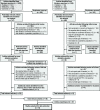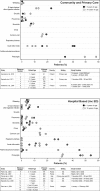Burden of paediatric influenza in Western Europe: a systematic review
- PMID: 23146107
- PMCID: PMC3534559
- DOI: 10.1186/1471-2458-12-968
Burden of paediatric influenza in Western Europe: a systematic review
Abstract
Background: Influenza illness in children causes significant clinical and economic burden. Although some European countries have adopted influenza immunisation policies for healthy children, the debate about paediatric influenza vaccination in most countries of the European Union is ongoing. Our aim was to summarise influenza burden (in terms of health outcomes and economic burden) in children in Western Europe via a systematic literature review.
Methods: We conducted a systematic literature search of PubMed, EMBASE, and the Cochrane Library (1970-April 2011) and extracted data on influenza burden in children (defined as aged ≤ 18 years) from 50 publications (13 reporting laboratory-confirmed influenza; 37 reporting influenza-like illness).
Results: Children with laboratory-confirmed influenza experienced hospitalisations (0.3%-20%), medical visits (1.7-2.8 visits per case), antibiotic prescriptions (7%-55%), and antipyretic or other medications for symptomatic relief (76%-99%); young children and those with severe illness had the highest rates of health care use. Influenza in children also led to absenteeism from day care, school, or work for the children, their siblings, and their parents. Average (mean or median) length of absence from school or day care associated with confirmed influenza ranged from 2.8 to 12.0 days for the children, from 1.3 to 6.0 days for their siblings, and from 1.3 to 6.3 days for their parents. Influenza negatively affected health-related quality of life in children with asthma, including symptoms and activities; this negative effect was smaller in vaccinated children than in non-vaccinated children.
Conclusions: Influenza burden in children is substantial and has a significant direct impact on the ill children and an indirect impact on their siblings and parents. The identified evidence regarding the burden of influenza may help inform both influenza antiviral use in children and paediatric immunisation policies in European countries.
Figures





References
-
- World Health Organization. Influenza (Seasonal) 2009. http://www.who.int/mediacentre/factsheets/fs211/en/index.html
-
- Heikkinen T, Booy R, Campins M, Finn A, Olcén P, Peltola H, Rodrigo C, Schmitt HJ, Schumacher F, Teo S, Weil-Olivier C. Should healthy children be vaccinated against influenza? A consensus report of the Summits of Independent European Vaccination Experts. Eur J Pediatr. 2006;165:223–228. doi: 10.1007/s00431-005-0040-9. - DOI - PubMed
-
- Usonis V, Anca I, André F, Chlibek R, Ivaskeviciene I, Mangarov A, Mészner Z, Prymula R, Simurka P, Tamm E, Tesović G. Central European Vaccination Advisory Group. Central European Vaccination Advisory Group (CEVAG) guidance statement on recommendations for influenza vaccination in children. BMC Infect Dis. 2010;10:168. doi: 10.1186/1471-2334-10-168. - DOI - PMC - PubMed
Publication types
MeSH terms
LinkOut - more resources
Full Text Sources
Other Literature Sources
Medical
Miscellaneous

